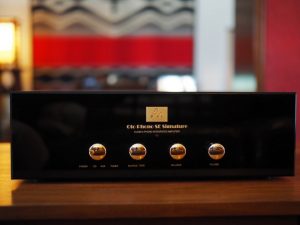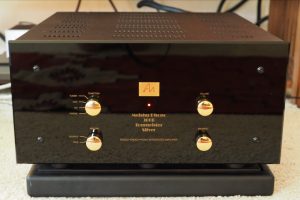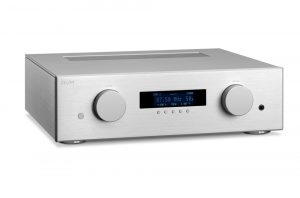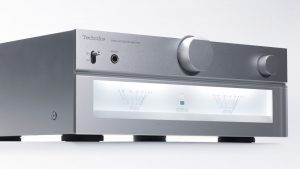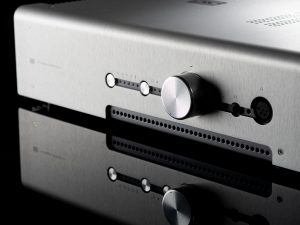PREMIERE
Flow by Allegro is a Hungarian company, founded in 2018, specializing in audio amplifiers. Its founder and designer is Mr. Bela Teleki, but it's a family business—50% is owned by his wife, Mrs. Andrea Ohar. We are testing its smallest amplifier, the Flow Three model.
Flow by Allegro is a small company based in Budapest, Hungary. It rarely introduces new products, and if it does, only when it is absolutely sure of them. That's why when it unveiled a new Mini amplifier with a transparent front panel and chrome chassis at the Warsaw Audio Video Show last year, I immediately arranged with Andrea Ohar and Bela Teleki to test it.
But a year has passed, and the device is still being refined. So in its place came the smallest model to date from this manufacturer, the Flow Three. Let me remind you, that the designer of Flow by Allegro has been retailing audio equipment since 1998. His first company, founded with a colleague, was initially called Agria Audio. However, his first own audio showroom was already established under the name Allegro Audio—it was located in Eger and had been operating since 2015. Since 2016, Allegro Audio operated as a distributor for REGA, Chario and others, and in 2018 a new showroom was opened in Budapest.
But Mr. Teleki wanted something more—he wanted to have his own device. As he said in an interview with us on the occasion of the Flow One test, the idea for an amplifier that could also satisfy his own musical needs had been sitting in his head for many years. Its realization began in 2017, when the Flow by Allegro brand was established. He continued:
It was then that the amplifier took its present form, which I arrived at through a lot of experimentation, research, trials and tests. Development, by the way, is still ongoing—our ambition, mine and my wife's, who has been my partner since 2016, was to create a final "product" that could be marketed and that could begin its international journey.
Wojciech Pacula, Flow by Allegro Flow One, High Fidelity 212, Dec. 1st. 2021, HERE, accessed: 22.11.2023.
The company debuted on the international stage in 2018 at the Audio Show/Video Show Prague HERE PL, and I liked the Flow One amplifier presented at that time so much that we awarded it the Best Sound award.
Three
Model Flow Three is the cheapest amplifier in this Hungarian manufacturer’s range. Above are, as you might have guessed, the Flow Two and Flow One models; we tested the latter in High Fidelity exactly two years ago. The Flow Three is a medium-power solid-state amplifier, built using MOSFET field-effect transistors operating in class AB in a push-pull configuration.
Bela Teleki, Flow by Allegro’S designer
The company's devices share almost the same electronic circuits and a very similar chassis, differing only in height. Also common is the artistic motif of using a wooden, very nicely crafted front panel instead of an aluminum one. The front panel can also be made of hand-polished, semi-matte Brazilian walnut wood or lacquered in a high-gloss finish (for an extra charge).
The front panel is more than a decoration, it is also a declaration of sorts. The company says: In the long process of product development, our goal was to prepare a family of amplifiers that would be able to provide not only a unique musical experience - a true state of Flow—which, due to its distinctive design elements, was to become an integral part of any home environment. The chassis design was inspired by Mihaly Csíkszentmihályi, a well-known psychologist, and his original concept of "flow," as indicated by the wavy lines on the front of the units. In the Flow by Allegro Audio amplifiers, we wanted to achieve something that would conjure up in the listener's soul that magical phenomenon of flow that good music can create in us.
The company's amplifiers are minimalist devices. I wanted to write that they are reminiscent of what we had to deal with before the streaming era came along, but that wouldn't be entirely true. The competition between purist products and those that included all possible amenities has been going on since the 1970s, when products from Japanese companies began to hit the world markets, in large quantities. The presence of a file player, DAC or Bluetooth connection in 21st century amplifiers is simply an extension of that trend.
The Flow Three is an absolutely classic representative of the minimalist trend in audio. It's a pretty big, but low-profile, integrated amplifier, offering four line inputs on RCA jacks and a pair of speaker outputs. The only convenience-oriented feature is the remote control. A very nice one, by the way, as it is made of wood of the same type as the front panel. There are no buttons nor knobs on the front panel, as the volume control and input selection are controlled from the remote—their status is indicated by a red LED display.
The amplifier outputs 40-watts into an 8 ohm load and 75-watts into a 4 ohm load, which is exactly half that of the company's top model, the Flow One. And it costs quite a bit less than half. The manufacturer's stated frequency response is wide, extending from 8 to 72kHz, distortion is a nice <0.09%, and the signal-to-noise ratio is 96 dB. Let's face it: these are not some exceptional parameters. And that's because the parameters themselves weren't the point here. The designer of this company relies on the correlation of listening and measurement results, and if the latter are in conflict with the sound, he chooses the results of his listening tests.
Let’s add, that the amplifier is a dual mono design, except for the passive preamplifier section. The latter is based on a relay-switched resistor ladder. Hence the quiet clicking can be heard when one adjusts volume. This circuit was developed in-house. And one more thing—the amplifier does not feature regular feet, but three wide wooden cones instead.
SOUND
HOW WE LISTENED
The Flow Three amplifier stood on its wooden feet on the top shelf of a Finite Elemente Master Reference Pagode Edition MkII rack. They should have been complemented by appropriate pads to keep it from sliding on the shelf, but I didn't find any in the package. I did, however, use the excellent "panzer" plywood pads made by run by a Pole, Berlin-based Pathe Wings company, the PW-AVSH.
The amplifier was connected to Harbeth M40.1 speakers via Crystal Cable Art Series Da Vinci speaker cables. An Ayon Audio CD-35 HF Edition SACD player was used as the signal source, via Siltech Triple Crown interconnects. Power was supplied via a Harmonix X-DC350M2R Improved-Version AC power cable plugged into an Acoustic Revive RTP-4eu Ultimate power strip.
Albums used for the test | a selection
John Scofield, Uncle John's Band, ECM Records/Universal Classic Jazz & Rock UCCE-1201/2, 2 x SHM-CD (2023).
Mike Bloomfield, Al Kooper, Steve Stills, Super Session, CBS/Sony Records Int'l SICP 10144, 7-inch mini LP, SACD/CD (1968/2023).
Carol King, Tapestry, Ode Records/Epic/Sony Music Labels SICP-10120, "We Got Rock! Series", 7-inch SACD/CD (1971/2017), HERE.
SZCZYL, Polska Floryda, Sony Music/Tidal, FLAC 24/44,1 (2022).
Shawn Colvin, Uncovered, Fantasy/Tidal, FLAC MQA Studio 24/88,2 (2015).
Sam Rydel, Fought & Lost, Xploded/Tidal, MQA Studio 24/44,1 (2023).
It was quite simple, the first few bars from John Scofield album’s opening track Uncle John's Band and it was clear that the Flow Three, though inexpensive, was a full-blooded amp. The intro played by the drummer on cymbals, slowly developing into the track, the leader's guitar in the foreground and quite far away, gently strummed double bass strings, all had a very, very good—I couldn't help myself—flow.
It's a device that presents events in a succinct, saturated way and closer to us rather than further away. It doesn't push phantom images over the line connecting the speakers, but it's clear that it prefers a close perspective. That's why it's so cool, so unforced presentation. It doesn't have a "offensive" feel to it, it doesn’t ever feel aggressive, or pushy. In fact, it's one of the least bright and edgy sounds I've heard in a long time. And, importantly, it resembles in structure, timbre and palpability what we get with tube amplifiers.
For all its saturation, this is not a "sweet-sounding" amplifier, that is, it does not over-saturate the sound. It is true that it gently rounds off the attack of the signal, I could already hear this with Scofield's guitar, I also heard it with Mike Bloomfield's guitar from the first part of the Mike Bloomfield, Al Kooper, Steve Stills Super Session album. I've been listening to it lately from the latest SACD version, released in Japan by Sony Records Int'l. But it's with it that I heard that it's not about over-saturation, but about deepening the sound.
The difference seems small, but it results a really different presentation. The one we get with the Flow Three is dynamic and open, but both the dynamics and the opening are controlled. It's not a disorderly outpouring of sounds, but a ordered band, a flowing procession of events. It was immediately audible that the aforementioned album was recorded to emphasize the aggressiveness of the guitar, placed in the left channel, and the presence of the Hammond B-3 organ, thus more pronounced than if it had been mixed into the whole.
Such freedom is often part of a sound founded on high power and high resolution. The latter is obvious—this is an amplifier that shows a lot of information. Its power, on the other hand, is not particularly high. But there's something about it that makes amplifiers such as the Naim One, or the Leben CS-300, or the Heed Obelisk, after all, small, not very powerful, perfectly drive the speakers and it's hard to catch them struggling, which could manifest via sound compression but it doesn’t.
I assume this is a derivative of technology - the amplifier has a very large, 500-watt transformer and separate power supplies for both channels - but also of the designer’s feel. After all, this kind of energy transfer while maintaining a refinement of the sound requires a lot of time spent listening to the device and a lot of experience. And this cannot be gained in a shortened "course," nor by reading reviews and descriptions of equipment. Nor can it be learned from books, because they talk about general problems, and each device is a special case. That's why this not-so-powerful amplifier coped admirably with the difficult Harbeth 40.1 and showed the powerful bass so well on the Super Session album.
Our albums
Mike Bloomfield, Al Kooper, Steve Stills, Super Session. CBS/Sony Records Int'l SICP 10144. 7-inch mini LP, SACD/CD ⸜ 1968/2023
On September 13th of this year, the Japan branch of the Sony label released Super Session, an album by three musicians, Al Kooper, Mike Bloomfield and Steve Stills. The idea for it came from the former, an American songwriter, producer and musician, the "father" of the Blood, Sweat & Tears group (1967) and session musician for such stars as Bob Dylan—organ on Like a Rolling Stone, and Rolling Stones—horn on You Can't Always Get What You Want.
For the recording of Super Session, Kooper invited guitarist Mike Bloomfield, with whom they had previously collaborated on Bob Dylan's breakthrough album Highway 61 Revisited (1965), with whom he also played at a controversial concert at the Newport Folk Festival in July 1965. It was to be a low-cost, quickly recorded album, so in May 1968 he rented the CBS Columbia Square studio in Los Angeles for just two days. As Kooper wrote in the booklet for the 2014 reissue, he was to be producer and play organ.
On the first day, in a quintet, with musicians from Bloomfield's previous band and "Fast" Eddie Hoh drummer, they recorded blues-based instrumental pieces in a series of jams, but also a piece called His Holy Modal Majesty, a tribute to the modal jazz variety played by John Coltrane, who had died the year before. On the first day, they returned to their rented house at two in the morning to catch a few hours of sleep—all except the guitarist.
The next day, when almost everyone was ready in the studio to record the rest of the material, it turned out that Bloomfield, who was suffering from insomnia, got into a cab at three in the morning and returned to San Francisco. In his opinion, he had done his job and the album was ready. Kooper thought quite differently. Since he had a rented studio for another day, he called, as he recalls, all the guitarists in California who would be free. The only one who called back was Steven Still, who would just be leaving the Buffalo Springfield band.
Disregarding the fact that he is still under contract with another label, the producer invited him to the studio. They finished their work, again, at two in the morning. Super Session is thus an album in two parts—on the LP on two sides: an instrumental one, with Mike Bloomfield, and with Steven Still, who not only played guitar, but also sang. The original material was recorded on an eight-track tape recorder.
The album was released in 1968 on LP in two versions—stereo and, in Japan, quadraphonic; a reel-to-reel tape version was also released. The album climbed to No. 12 on the Billboard 200 chart, where it stayed for 37 weeks, and received a gold album status from the RIAA. This was the first ever "big" album by a so-called supergroup, an idea popularized in subsequent years by, for example, Blind Faith or Crosby, Stills & Nash.
In 2004, Sony Records offered Kooper a remix of the album planning a stereo release and 5.1 on SACD. He chose Bob Ludwig for mastering. However, the album was not released at the time. That same year, in an interview, Kooper said that the label's entire multichannel division had been shut down and the staff laid off. It wasn't until 2014 that the remixed material was released by a small, specialized label called Audio Fidelity. The material on the latest 7-inch release is a return to the original stereo and quadraphonic mix. The material was transcribed from the original tapes to hi-res files and mastered in DSD.
The sound of the new 7-inch version is very, very good. Dense, low, saturated, and very resolving. The bass presentation is very nice, which was shown the way an electric bass should be shown, that is, tight, but also soft. The space is wide, as the sound engineer and producer spread the instruments by channels—guitars to the left, drums and Hammond organ to the right, and brass instruments in the middle. The division between left and right channels was also maintained for the second session with Stilt. However, this part of the album is more compressed, probably due to the presence of vocals. These are very nice, although also heavily compressed.
The Audio Fidelity version has a slightly lower average volume level, suggesting lower compression. In fact, it seems to be the more heavily compressed version. It's still very good playing, the bass is saturated here too, but the whole thing has lower energy. So the second part of the disc, with vocals, seems more "in tune" with the first, as the Sony version is the one that is more put out. Still, the Audio Fidelity disc is also very good. Only that the energy, and above all the resolution of the 7-inch mini LP version, are much, much better.
Therefore, we get with the Flow Three is a warm sound that is also a dynamic and differentiating. And how about resolution? Good differentiation is one of its components, so we already know it's good. Carol King's album, titled Tapestry, released in 2017, also in Japan, also by the Sony division and also in a beautiful 7-inch mini LP format, is much less selective and resolving than the two previously referenced. And that's also how it was shown.
But the whole thing had "a flow" because it is, after all, a beautiful album. The Hungarian amplifier brilliantly conveyed King's dark voice, her bright acoustic guitar and dynamic percussion. The latter's big drum, or so-called "kick-drum" was kicking hard, and against the background of the rather withdrawn sound of this album, it seemed extremely dynamic and "present. This was a really good reproduction, especially since the Flow Three handles bass really well. It is well attenuated on the one hand, but on the other it has a soft, very natural, one could say—physiological character.
It's interesting, but this range seemed to me better differentiated than the rest of the band. Not that there were any problems with it. But the way Mr. Teleka's amplifier shows the differences between double bass, bass guitar, or bass from the Poland Florida album by the Polish rapper who goes by the pseudonym Szczyl, was exceptional. In the track Cień he is vocally assisted by Piotr Rogucki, and the whole thing has the "feel" of post-punk bands from the early 1980s, soon to go the way of New Romantic music.
The drums in this track are played from a vintage machine, or at least that's what they sound like, which the amplifier showed nicely. It didn't boost its lower range and let it pound out the rhythm with precision, with attack and a slight dryness. And yet, when I played Baker Street, a cover of Gerry Rafferty's song performed by Shawn Colvin, I heard a low, dense sound. The distinctive sound of the electric (!) double bass, played here by Glenn Fukunaga, was both low, like that of a double bass, and a little hard, like that of an electric guitar. And on top of that, the beautiful guitars played by Shanna Colvin - it was a truly captivating performance.
Summary
The Flow Three Amplifier from Hungarian company Flow by Allegro is an example of a device with a thoughtful, smooth, and well-arranged sound. Even heavily compressed tracks such as Sam Rydel's Fought & Lost, accompanied on guitar by Brian May (Queen), are not massacred. The vocals here were bright, but not too bright. Anyway, this entire track, from the soundtrack to the third season of the TV series Ted Lasso, was well-paced.
The device does not display a big soundstage, this is not the case. It gives something else—a big sound. And it does this through a rather close perspective and by saturating the presentation with information. So we get a mix of on the one hand warm and on the other differentiating sound. Playing the tracks saved in my Tidal app as "favorites" each time changed my perspective, sound quality, dynamics, etc.
Each time it was a mature, dense and somewhat warm, high-resolution presentation. In addition, with perfectly differentiated high and low, near and far, bright and dark sound. It sounded somewhat familiar, as it reminded me of a scaled-down sound of my system. A very, very good device.
DESIGN
You will find key information regarding design and features of the device in the first part of the test, so we will not repeat it. Let's just add that the display, which reads the selected input and voice strength, where '0' corresponds to minimum and '61' to maximum volume level, dims a moment after we make some change. Also well thought out are the RCA inputs, which are far enough apart that we can use any interconnects. On the rear panel there is also an EIC power inlet with a switch and a ground terminal. On the former, a red dot marks the polarity—it's worth remembering!
The chassis is made of three parts: a wooden milled front, a bottom with rear panel, and side panels. The metal part of the chassis is a thick, rigid, heavy-gauge steel covered with black powder coating. From underneath, wooden cones acting as feet were screwed on.
The tested amplifier consists of two power amplifiers with a passive preamplifier and input selector. Each of these components was made on a printed circuit board. A selector and a passive, discrete attenuator were bolted to the rear panel. The latter features precision Dale resistors switched by small relays; the same relays are also used in the input switching circuit.
The power amplifiers are bolted to medium-sized heat sinks, and the whole thing is bolted to the bottom of the case, vertically. The board shows very nice passive components, such as Wima and Vishay capacitors, as well as precision resistors. The current signal is amplified in three, working in parallel, pairs of MOSFET transistors in a push-pull arrangement, in class AB. The signal to the speaker terminals is routed via cool cables from French company Viard Audio's HD-Line. It's a braided copper cable the company calls Cu-VHQ. The manufacturer declares that it is better than OCC (Ohno Continuous Cast) copper.
The same board houses the power supply section—stabilized for the input section and classic for the output. It runs four, high-quality Vishay capacitors shorted with polypropylene capacitors—this helps to linearize their characteristics for high frequencies.
Bolted close to the front panel, the large 500W (!) toroidal transformer comes from the Hungarian company Tortek Elektronik. It features two secondary windings, so we are dealing with an almost dual-mono circuit. Let's add that the transformer is damped from underneath with a cork pad and bituminous mat. It is bolted from the top with a large copper sheet.
It is a very good design featuring expensive, high quality components.
Technical specifications
- Nominal output: 40 W/8 Ω | 70 W/4 Ω
- Input impedance: 22 kΩ
- Frequency range: 8 Hz-72 kHz
- THD + Noise: <0.09%
- SNR (Signal to Noise Ratio): 96 dB
- Dimensions (W x H x D): 440 x 100 x 430 mm
- Weight: 16 kg
- Finish options: hand-polished semi-matte Brazilian walnut wood or piano lacquer (for additional fee)
- Price (when reviewed): 5900 EUR
ALLEGRO AUDIO Ltd.
Andrássy út.20. door bell: 16
H-1061 Budapest. HUNGARY
MADE IN HUNGARY
Provided for test by: Allegro Audio
text by Wojciech Pacula
images Allegro Audio, High Fidelity
























